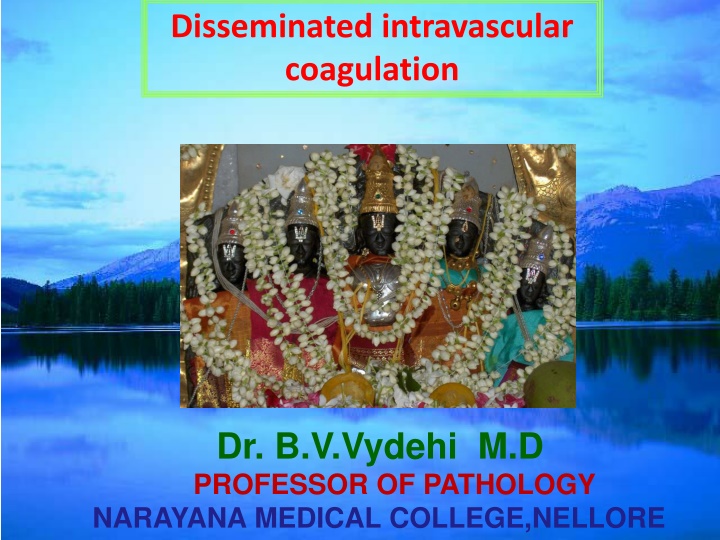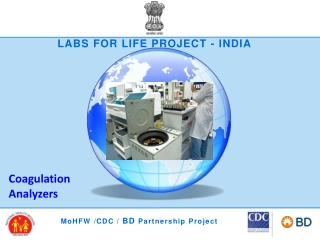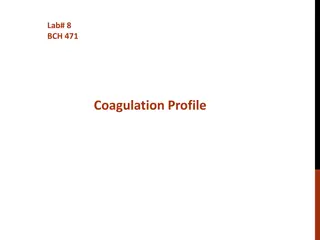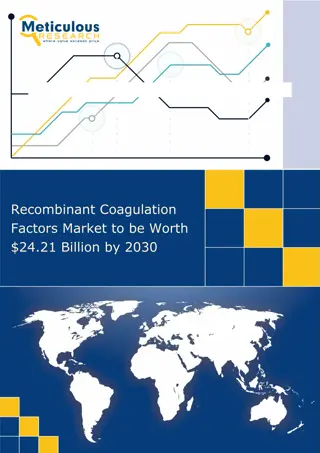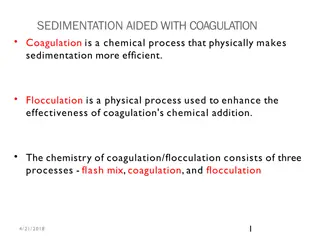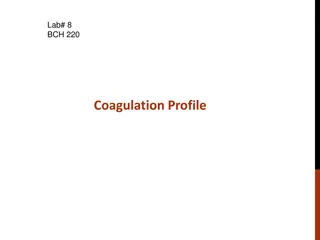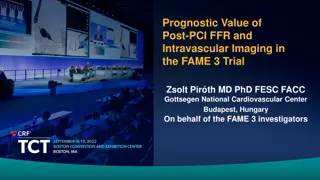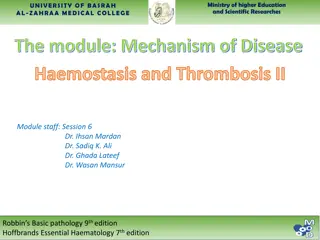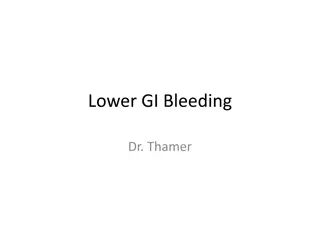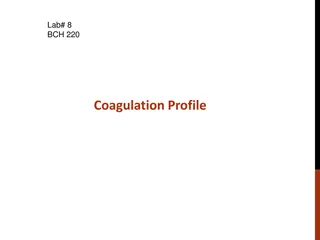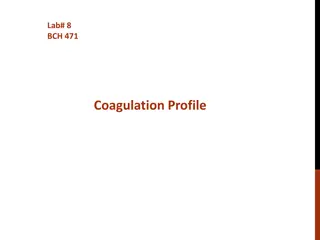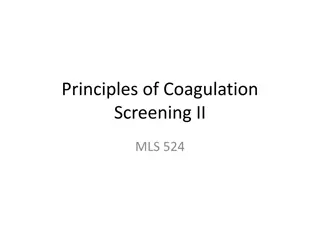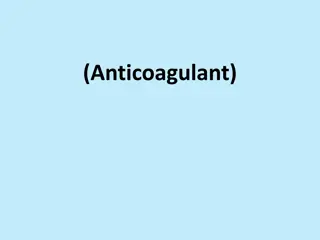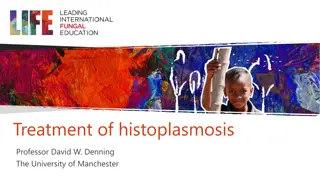Disseminated Intravascular Coagulation
Dhrombohemorrhagic disorder secondary to various diseases, characterized by coagulation activation and microthrombi formation. Major disorders associated with DIC include obstetric complications, neoplasms, and tissue injuries. Pathophysiology involves tissue thromboplastin sources, endothelial injury, massive tissue destruction, sepsis, and clotting factor consumption, leading to ischemic tissue damage and bleeding.
Download Presentation

Please find below an Image/Link to download the presentation.
The content on the website is provided AS IS for your information and personal use only. It may not be sold, licensed, or shared on other websites without obtaining consent from the author.If you encounter any issues during the download, it is possible that the publisher has removed the file from their server.
You are allowed to download the files provided on this website for personal or commercial use, subject to the condition that they are used lawfully. All files are the property of their respective owners.
The content on the website is provided AS IS for your information and personal use only. It may not be sold, licensed, or shared on other websites without obtaining consent from the author.
E N D
Presentation Transcript
Disseminated intravascular coagulation Dr. B.V.Vydehi M.D PROFESSOR OF PATHOLOGY NARAYANA MEDICAL COLLEGE,NELLORE
Disseminated Intravascular Coagulation (DIC) Acute / subacute / chronic thrombohemorrhagic disorder occurring as a secondary complication in a variety of diseases Characterized by activation of coagulation sequence formation of microthrombi through out the microcirculation
Disseminated Intravascular Coagulation (DIC) Endothelial Damage Coagulation factors Activation of coagulation Platelets FDPs
Major Disorders Associated with DIC (Disseminated Intravascular coagulation) Obstetric Complications Abruptio placentae Retained dead fetus Septic abortion Amniotic fluid embolism Toxemia Infections Gram-negative sepsis Meningococcemia Rock Mountain spotted fever, Histoplasmosis Aspergillosis Malaria
Major Disorders Associated with DIC (Disseminated Intravascular coagulation) Neoplasms Carcinomas of pancreas, prostate, lung, and stomach Acute Promyelocytic leukemia (APML) Massive Tissue Injury Trauma Burns Extensive surgery Miscellaneous Acute intravascular hemolysis, snakebite, giant hemangioma, shock, heat stroke, vasculitis, aortic aneurysm, liver disease etc
Pathophysiology of disseminated intravascular coagulation Sources of Tissue Thromboplastin: Bacterial endotoxins in gram negative sepsis Placenta in obstetric complications Granules of leukemic cells in APML Mucin of certain Adenocarcinomas Endothelial injury site
Pathophysiology of disseminated intravascular coagulation Endothelial injury Massive tissue destruction Sepsis Release of tissue factor Platelet aggregation Widesppread Microvascular thrombosis Activation of plasmin Microangiopathic Hemolytic anemia Vascular occlusion Consumption of clotting factors and platelets Proteolysis of Clotting factors Ischemic tissue damage Fibrinolysis Fibrin split products Bleeding Inhibition of thrombin, platelet aggregation and fibrin polymerization
DIC Morphology Thrombi in decreasing order of frequency are found in : Brain, Heart, Lungs, kidneys, adrenals, spleen & Liver 1. Brain : Fibrin thrombi 2. Lungs : Fibrin thrombi in alveolar capillaries pulmonary edema & fibrin exudation Hyaline Membrane Disease (ARDS) micro infarcts
DIC Morphology 3. Kidneys : Small thrombi in glomeruli Severe cases Microinfarcts / Bilateral renal cortical necrosis 4. Adrenal cortex : Fibrin thrombi in meningococcemia massive adrenal hemorrhages (Waterhouse-Friderichsen syndrome) 5. Sheehan Post Partum Pituitary Necrosis : DIC complicating labor & delivery
DIC Clinical course Common patterns Cyanosis, Dyspnea, Respiratory failure Convulsions & Coma Oliguria & ARF Progressive or sudden circulatory failure & shock
DIC Clinical course Common patterns Acute DIC: Common with obstetric complications or major trauma Dominated by a bleeding diathesis Chronic DIC: Occurs in cancer patients Present initially with thrombotic complications
DIC Laboratory Findings Low platelet count Blood Smear : Microangiopathic hemolytic anemia PT, APTT, TT Prolonged Plasma fibrinogen levels Reduced FDP are raised
Diagnostic Algorithm for the Diagnosis of overt DIC I. Risk Assessment : Look for any underlying disorder; If present, proceed further II. Order global coagulation tests: Platelet count, PT, Fibrinogen, FDP
Diagnostic Algorithm for the Diagnosis of overt DIC III.Scoring of global coagulation tests results 1. Platelet count : > 1.0 lakh =0 ; < 1.0 = 1 ; < 50000=2 2. Elevated fibrin related markers : (Soluble fibrin monomers / FDP) No increase=0 ; Mod. Increase=2 ; Strong rise =3 3. Prolonged prothrombin time : < 3 sec =0 ; 3-6 sec=1 ; > 6 sec=2 4. Fibrinogen levels : 1.0 g/dl=0 ; < 0.1 g/dl=1 Calculate score : If 5 compatible with overt DIC Repeat scoring daily
Algorithm for evaluation of Factor deficiencies PT & APTT Normal: F XIII Deficiency PT :Prolonged APTT :Normal PT :Normal APTT :Prolonged PT :Prolonged APTT :Prolonged F VII F VIII,IX ,XI & XII F II,V, X
Disorders of Coagulation Rare Usual large & solitary Purpuric Disorders (Disorder of platelets or vessels) Findings 1. Petechiae 2. Superficial ecchymoses 3. Deep dissecting hematomas 4. Hemarthrosis 5. Delayed bleeding 6. Bleeding from superficial cuts & scratches 7. Sex of patient 8. Positive family history 9. Platelet count 10.Coagulation factors Characteristic Small & multiple Characteristic Rare Characteristic Common Rare Rare Minimal Persistent, often profuse 80 to 90 % - Males Common Common in females Rare (except VWD) Usually reduced Usually normal Usually normal Usually defective
